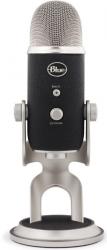Recording Time
Buy Now...


click image to enlarge
While many will regard the Yeti as being kin to Big Foot and the Abominable Snowman as a member of the legendary ape-like family, the people at Blue Microphones are of a different opinion. They know that the Yeti is the brand name given to a microphone developed by the company. The latest version of this microphone, and the subject of this review, is the Yeti Pro, which comes with the claim of being the world’s first USB microphone combining 24 bit/192 kHz digital recording resolution with an analogue XLR output.
Opening the box reveals the rather impressive looking microphone unit, USB lead, XLR Y-cable and a small multi-lingual Getting Started guide. The Yeti Pro microphone is certainly an impressive looking device as it stands on your workspace. Looking like a combination of a cartoon-style alien and the loveable R2D2 robot from the Start Wars films, the Yeti Pro stretches up to a height of 295mm when attached to its stand. You can easily remove the microphone from the stand but it then becomes rather cumbersome to hold as you are unable to stand it upright as the base holds the necessary connecting leads. It is also far harder to re-attach the microphone to the stand once it has been removed.
Perched on top of the microphone’s cylindrical black body with a circumference of 22cm (another reason why you don’t want to detach it from the stand and hold it) is a silver mesh cap. Positioned beneath this grill, and conveniently out-of-sight, are three 14mm condenser capsules which give the user the choice of four switchable pickup patterns. You can select from stereo, cardioid, omni-directional or bi-directional. Mounted on the front of the microphone’s body (easily recognised by the Blue logo) are the mute button and the master volume silver knob. Located at the rear are control wheel buttons for MIC gain and selecting from the four patterns. Checking out the base of the Yeti Pro reveals connection sockets for USB, Stereo XLR and the standard 3.5mm jack socket for attaching a headset.
Setting up the Yeti Pro to work with a computer was not as straightforward as it could have been and the blame for this needs to be laid on the Getting Started guide. As is my usual practice, I set out to follow the supplied instructions to the letter. The first instruction was to link the Yeti Pro to the computer via the supplied lead and then to download the appropriate driver from the provided website. Once the driver had been located, which turned out to be a ZIP file, and then downloaded, you are asked to run the “Yeti Pro USB 2.0 Driver.exe” file. Unfortunately this file did not form part of the ZIP file. Instead you need to run the “Setup” file. You are then asked to plug in the Yeti Pro which, if you have followed the instructions, you have already plugged in.
According to the instructions you then need to access the Control Panel and select the Sound option. You are advised to pick the “Yeti Pro Stereo Microphone” option from both the Recording and Playback tabs. In neither case is the Yeti Pro choice available. You actually need to go for the XMOS XSI-11 option.
The Yeti Pro gives you the option of linking it to a computer (USB) or a stereo preamplifier or mixing console (XLR). This is an either/or option rather than one giving dual simultaneous connectivity.
As mentioned earlier, there are four recording modes available for different types of situations. Selecting Stereo mode is best suited for recording vocals, ensemble choirs and instruments with the Yeti Pro being positioned from with 2 inches up to several feet away. Cardioid mode is the preferred choice for podcasts and voice-overs plus vocals and instrument recoding when you need to restrict the audio from right in front of the microphone.
As its title implies Omni-directional will take audio from all directions. It is the ideal choice for conference calls, field recordings and events. The final mode of Bi-directional gathers audio from the back and front of the microphone while rejecting sounds from either side. It should be considered for use with interviews and vocal duets. With an appropriate headset attached, you can monitor recordings as they occur.
When recording is happening, a red light flashes on the unit’s mute button with the light remaining solid when the microphone is turned off. While other may disagree, I would have preferred a solid light for recording and no light to indicate the unit was not in use. Audio quality, as you would expect from a product in this price range, in all modes was of a high standard. The Yeti Pro is a product that will appeal to the professional rather than casual user.
Expect to pay in the region of £210 for this device which is compatible with Windows and Mac systems. Windows user will need to be running XP and later with 256MB of RAM as a minimum. With a Mac system you will need to be running OSX 10.6.4 and higher with 256MB of RAM.
| add to del.icio.us | Digg this review |
| StumbleUpon | |












 !!
!!











